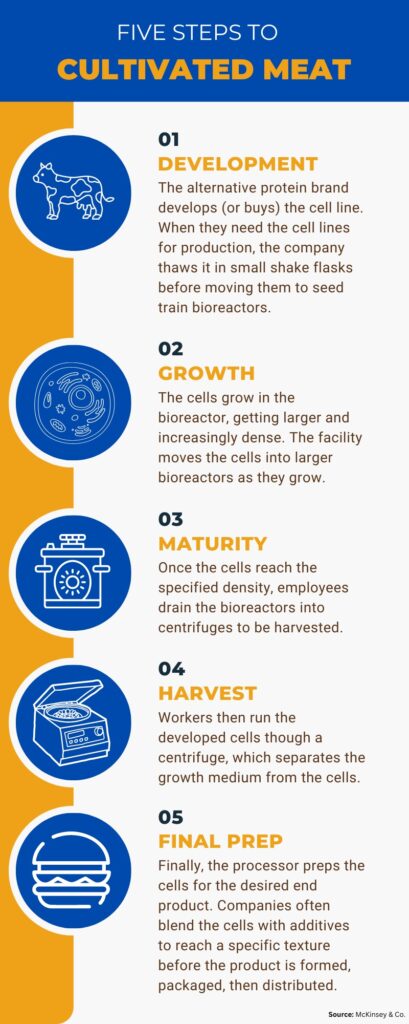Standardized specifications and transparency help drive the market for cultivated proteins. The business continues to grow, and more brands are making moving into the market. So, it’s essential to establish a level playing field where every producer adheres to the same quality benchmarks. This standardization allows consumers and regulators to compare companies fairly on factors such as nutrition, taste, texture, and sustainability.
Moreover, standardized specifications help foster a more transparent marketplace. Consumers are more likely to embrace a product when they know what they’re buying. In addition, increased transparency ensures that buyers and sellers can build a relationship based on trust.
In November 2021, the Food and Drug Administration (FDA) approved Upside Foods’ cell-cultured meat after completing its initial premarket assessment. The FDA said it had no more questions about the safety of the company’s chicken. This acknowledgment represented a monumental step toward more ethical and healthier alternative meat products.
But the approval didn’t draw universal praise. Some consumer advocacy groups have raised critical concerns about lab-grown meat.
To stay ahead of regulators – and critics – brands must adopt standardized and transparent specification programs. Such programs will help convince customers of the potential of cultivated proteins.
Regulatory status of cultivated proteins
The two agencies that oversee U.S. food safety, the United States Department of Agriculture (USDA) and the FDA, have established regulatory authority over lab-grown meats. USDA oversees the supply of poultry, meat, catfish, and processed egg products. While the FDA oversees all other imported and domestic foods, including seafood.

In 2018, the two agencies hosted the first of several public participation meetings on the potential hazards of cell-culture technology, product labeling, and oversight considerations.
After more meetings, the agencies issued an interagency agreement detailing their responsibilities overseeing cultivated meat products. The agencies defined these roles based on their respective areas of expertise.
According to the agreement, cultivated protein facilities must comply with all FDA food safety requirements, including:
- Food facility registration.
- HARPC (Hazard Analysis and Risk-Based Preventive Controls).
- GMPs (Good Manufacturing Practices).
The FDA oversees the cell-culturing process for poultry and meat products to the harvesting stage. This oversight covers cell collection and cell bank development and maintenance. And it maintains the sole jurisdiction over seafood.
USDA takes over after the cells the company harvests them from the bioreactors. Its role includes inspecting the meat cells and products from poultry and livestock.
Establishing these standardized specifications and appointing regulatory authorities inspires confidence and builds consumer trust in cultivated protein products. All producers and suppliers are aware of the regulatory framework, making compliance easier. Likewise, the regulatory authorities know their roles and can effectively enforce regulations without conflict.
What to call cultivated proteins?
Cell-cultured protein goes by many names, including lab-grown, cultured, cultivated, cell-based, and in-vitro. All these terms refer to the product of developing protein cells with a growth medium under controlled conditions.
Marketing and naming lab-grown products have become murky legal and regulatory concerns. For example, some suggestions for naming cell-cultured meat include the term “clean.” However, critics argue that the word reflects a bias against other products and can affect how consumers perceive them.
Though the FDA and the USDA are aware of this marketing and naming concern, neither agency has proposed a regulatory solution – yet. While lawmakers have introduced several bills, Congress has failed to act. Some of these pieces of legislation seek to clarify when traditional terms like “meat” and “milk” can be used. And they want to restrict these terms to traditionally raised livestock and require lab-grown products to use the word “imitation.”
Some states have banned lab-grown products from using “meat” on their labels. This pushback is probably due to inaction by federal agencies and Congress in passing legislation on the marketing and naming of cell-cultured protein.
However, companies in the cultivated protein industry have challenged these laws in court. The companies argue they:
- Limit speech, violating the First Amendment.
- Aren’t necessary to protect consumers from misleading information.
- And represent an overreach that hampers competition in the marketplace.
In Asia-Pacific, more than 30 stakeholders in the lab-grown products industry agreed to use the term “cultivated.” This agreement represented a massive step toward shoring up trust in the marketplace and establishing regulatory standardization.
Standardized specs, transparency address safety concerns
The production of cultured proteins remains an emerging technology and presents a unique set of safety concerns. As a result, it’s unclear how the FDA and USDA will approach the process of approving lab-grown products.
For instance, the Government Accountability Office (GAO) highlighted several concerns about commercializing cell-cured meat:
- Potential antibiotic use. The GAO expressed concern about the possible use of antibiotics to produce cultivated meat. Another issue focused on the possibility of antibiotic residues in the final product.
- What type of scaffold would be used? Should companies use food-grade scaffolds? Does scaffolding affect the product? What agencies would evaluate scaffold safety?
- Growth medium. Can the growth medium affect the final product?
- Genetic engineering. Some stakeholders worried about whether commercialization would involve genetic engineering.
- Tissue collection. What animals would be used in the collection of biopsy samples? How often would samples be collected?
These are just some of the critical safety concerns. Failing to address these issues could hamper industry growth and foster consumer mistrust. But how should regulators address these concerns?
Transparency and standardized specifications are the best ways to build trust and address safety concerns. Transparency involves making clear all the processes involved in producing cultivated meats. It alleviates concerns ranging from tissue collection to processing.
Standardization and transparency also allow federal and state agencies to learn about the process and develop a more efficient supervisory framework. Though there can be hesitation approaching regulators, cultivated protein producers should understand that this gives them the perfect opportunity to be among the first entrants into the U.S. market. Upside Foods has, cementing its status as an industry pioneer.
Conclusion
The cultivated protein industry remains relatively young and still struggles with a variety of safety questions. As the industry pursues mainstream success, transparency and standardized specs are vital. Embracing that is a necessary step toward convincing consumers to embrace the new technology.
